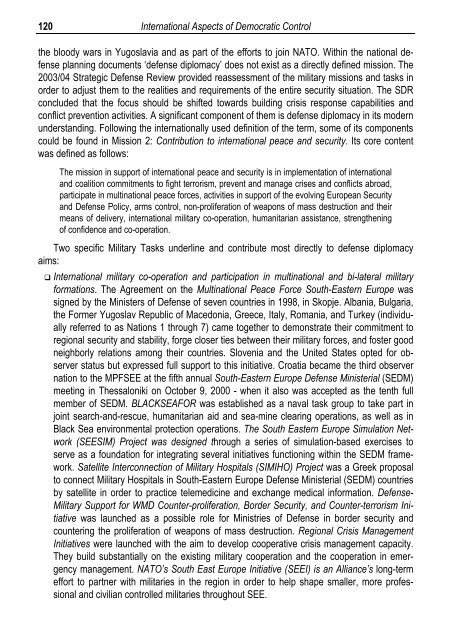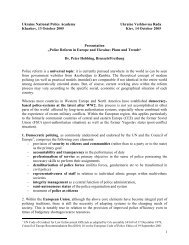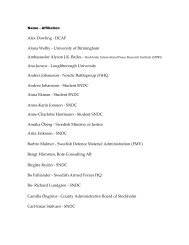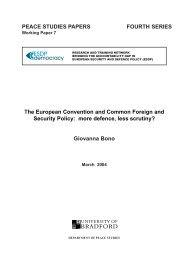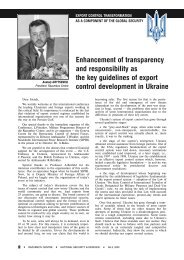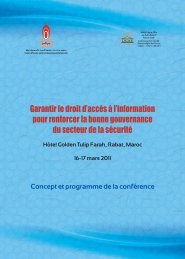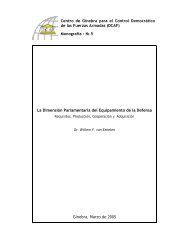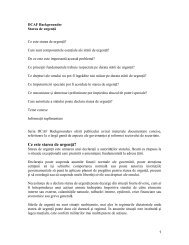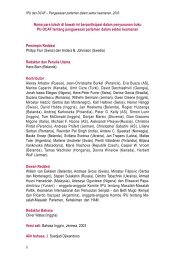Civil-Military Relations and Democratic Control of the Security Sector
Civil-Military Relations and Democratic Control of the Security Sector
Civil-Military Relations and Democratic Control of the Security Sector
You also want an ePaper? Increase the reach of your titles
YUMPU automatically turns print PDFs into web optimized ePapers that Google loves.
120<br />
International Aspects <strong>of</strong> <strong>Democratic</strong> <strong>Control</strong><br />
<strong>the</strong> bloody wars in Yugoslavia <strong>and</strong> as part <strong>of</strong> <strong>the</strong> efforts to join NATO. Within <strong>the</strong> national defense<br />
planning documents ‘defense diplomacy’ does not exist as a directly defined mission. The<br />
2003/04 Strategic Defense Review provided reassessment <strong>of</strong> <strong>the</strong> military missions <strong>and</strong> tasks in<br />
order to adjust <strong>the</strong>m to <strong>the</strong> realities <strong>and</strong> requirements <strong>of</strong> <strong>the</strong> entire security situation. The SDR<br />
concluded that <strong>the</strong> focus should be shifted towards building crisis response capabilities <strong>and</strong><br />
conflict prevention activities. A significant component <strong>of</strong> <strong>the</strong>m is defense diplomacy in its modern<br />
underst<strong>and</strong>ing. Following <strong>the</strong> internationally used definition <strong>of</strong> <strong>the</strong> term, some <strong>of</strong> its components<br />
could be found in Mission 2: Contribution to international peace <strong>and</strong> security. Its core content<br />
was defined as follows:<br />
The mission in support <strong>of</strong> international peace <strong>and</strong> security is in implementation <strong>of</strong> international<br />
<strong>and</strong> coalition commitments to fight terrorism, prevent <strong>and</strong> manage crises <strong>and</strong> conflicts abroad,<br />
participate in multinational peace forces, activities in support <strong>of</strong> <strong>the</strong> evolving European <strong>Security</strong><br />
<strong>and</strong> Defense Policy, arms control, non-proliferation <strong>of</strong> weapons <strong>of</strong> mass destruction <strong>and</strong> <strong>the</strong>ir<br />
means <strong>of</strong> delivery, international military co-operation, humanitarian assistance, streng<strong>the</strong>ning<br />
<strong>of</strong> confidence <strong>and</strong> co-operation.<br />
Two specific <strong>Military</strong> Tasks underline <strong>and</strong> contribute most directly to defense diplomacy<br />
aims:<br />
International military co-operation <strong>and</strong> participation in multinational <strong>and</strong> bi-lateral military<br />
formations. The Agreement on <strong>the</strong> Multinational Peace Force South-Eastern Europe was<br />
signed by <strong>the</strong> Ministers <strong>of</strong> Defense <strong>of</strong> seven countries in 1998, in Skopje. Albania, Bulgaria,<br />
<strong>the</strong> Former Yugoslav Republic <strong>of</strong> Macedonia, Greece, Italy, Romania, <strong>and</strong> Turkey (individually<br />
referred to as Nations 1 through 7) came toge<strong>the</strong>r to demonstrate <strong>the</strong>ir commitment to<br />
regional security <strong>and</strong> stability, forge closer ties between <strong>the</strong>ir military forces, <strong>and</strong> foster good<br />
neighborly relations among <strong>the</strong>ir countries. Slovenia <strong>and</strong> <strong>the</strong> United States opted for observer<br />
status but expressed full support to this initiative. Croatia became <strong>the</strong> third observer<br />
nation to <strong>the</strong> MPFSEE at <strong>the</strong> fifth annual South-Eastern Europe Defense Ministerial (SEDM)<br />
meeting in Thessaloniki on October 9, 2000 - when it also was accepted as <strong>the</strong> tenth full<br />
member <strong>of</strong> SEDM. BLACKSEAFOR was established as a naval task group to take part in<br />
joint search-<strong>and</strong>-rescue, humanitarian aid <strong>and</strong> sea-mine clearing operations, as well as in<br />
Black Sea environmental protection operations. The South Eastern Europe Simulation Network<br />
(SEESIM) Project was designed through a series <strong>of</strong> simulation-based exercises to<br />
serve as a foundation for integrating several initiatives functioning within <strong>the</strong> SEDM framework.<br />
Satellite Interconnection <strong>of</strong> <strong>Military</strong> Hospitals (SIMIHO) Project was a Greek proposal<br />
to connect <strong>Military</strong> Hospitals in South-Eastern Europe Defense Ministerial (SEDM) countries<br />
by satellite in order to practice telemedicine <strong>and</strong> exchange medical information. Defense-<br />
<strong>Military</strong> Support for WMD Counter-proliferation, Border <strong>Security</strong>, <strong>and</strong> Counter-terrorism Initiative<br />
was launched as a possible role for Ministries <strong>of</strong> Defense in border security <strong>and</strong><br />
countering <strong>the</strong> proliferation <strong>of</strong> weapons <strong>of</strong> mass destruction. Regional Crisis Management<br />
Initiatives were launched with <strong>the</strong> aim to develop cooperative crisis management capacity.<br />
They build substantially on <strong>the</strong> existing military cooperation <strong>and</strong> <strong>the</strong> cooperation in emergency<br />
management. NATO’s South East Europe Initiative (SEEI) is an Alliance’s long-term<br />
effort to partner with militaries in <strong>the</strong> region in order to help shape smaller, more pr<strong>of</strong>essional<br />
<strong>and</strong> civilian controlled militaries throughout SEE.


